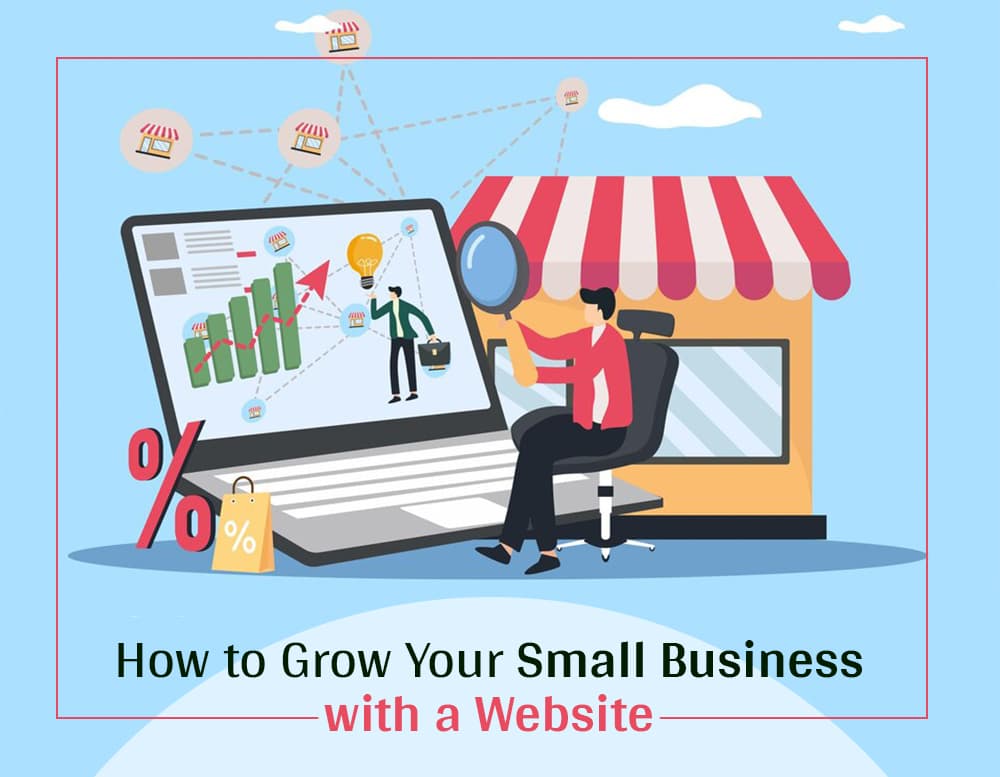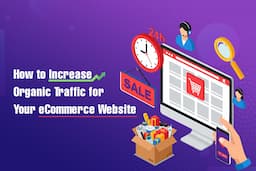How to Grow Your Small Business with a Website

In today's fast and digitized world, having a website is very important to grow one's small business and be competitive. A well-designed website allows tapping into new customers, building more credibility, and augmenting the revenues. It is representative of the face of your business in the online marketplace, whereby showcasing products or services to more people is allowed. This article describes how small businesses can effectively use the power of a website to scale up.
1. Building Credibility and Trust
A professional website instantly enhances the credibility of your business. In today's digital-first world, most of your probable customers will look up your business online before making any purchasing decisions. A polished and informative website reassures visitors that your business is legitimate and trustworthy.
Key Benefits:
First Impressions: The appearance and structure of your website will go a long way toward making a good first impression. People are more likely to believe in your business if you have invested in the online outlet.
Testimonials and Customer Reviews: Testimonials and customer reviews should be showcased on your website. In cases where visitors can see the experiences others have had with your business, they are more likely to convert.
Professional Design: It also reflects that your business is well-established and very reliable as access is provided to an easy-to-navigate sleek site.
2. Wider Reach
The website removes all geographical boundaries, and outreach is facilitated beyond the local area. Even a small business situated in a small town can reach out to customers living in other cities, regions, or even countries.
Key Strategies
SEO-Search Engine Optimization: Optimizing your website with a search engine will eventually increase visibility on Google, Bing, and other types of platforms. With effective keyword research, meta tags, and quality content strategies, your website would hold a higher rank, and thus, it becomes quite easy for your potential customers to notice.
Targeted Content: Targeted content helps you to sell to your ideal customer. By crafting blog posts, product descriptions, and landing pages that speak to your target market's needs, your customer base will grow naturally.
Social Media Integration: Here, the website collaborates with social media work. This is through sharing of blog posts, features of new products, promotions on social media platforms such as Instagram, Facebook, and Twitter. This drives traffic back to your website.
3. Offering 24/7 Availability
Unlike a brick-and-mortar shop that operates in accordance with specific hours, your site is up and running day and night. This lets customers learn about your business and order from you at any time that works best for them.
Benefits
E-Commerce: Adding e-commerce to your site enables customers to buy products or book services at any time, thus furthering the possibility of your business to a great extent.
Self-help resources: Provide the frequently asked questions, product guides, and other downloadable resources that will enable customers to find answers to their questions even during odd hours outside of business hours.
Automated Sales: You can automate certain sales processes, such as ordering products, email marketing, and even customer support with AI-powered chatbots.
4. Lead Generation
A website is one of the most potent ways of generating leads for any business. Be it direct inquiries, subscription to newsletters, or download of informative resources such as whitepapers or e-books, a well-structured website can be a powerhouse in generating leads.
Lead Generation Tactics
Lead Forms: Place forms across your website where visitors can sign up to get information, quotes, or subscribe to your newsletters. In this way, you will be able to capture the contact and follow up with them for possible clients.
CTA Buttons: A strong call to action will indicate to your visitors the exact action that should be taken, such as setting up a consultation, requesting a demo, or making a purchase.
Landing Pages: Create different landing pages for targeting specific campaigns or products. Each one of these pages can be designed to cater to a particular persona for improved conversions.
5. Highlight Your Products and Services
This will also enable you to show your products or services in a neat and attractive manner. A website is just like a virtual storefront, where with good design, photography, and description, customers can get all the information they may need about your products and services.
Best Practices
High-Quality Images: Showcase your products or service using professional high-resolution images. High-quality visuals allow customers to imagine a product better, thereby improving conversion rates.
Detailed Descriptions: Give a full description of your products or services in detail. Specify their USP, benefits, and features.
Portfolio and Case Studies: If you are in a service-based business, then use a portfolio or case studies to indicate how you have helped other clients. This helps build up your credibility and gives the potential customer a better idea of what you can do for them.
6. Increasing Sales with E-commerce
This will surely give a major boost to the growth of those companies whose businesses involve the selling of products. E-commerce removes all the barriers that a physical store imposes on you, and you will have the option to sell your product across the globe.
How to Successfully Run an E-commerce Website
Ease of Use: The online store must be user-friendly. Menus must be simple, and there should be a search box so that whenever a visitor lands on your website, they can find what they are looking for without putting in too much effort.
Payment Gateways: Offer different options in terms of secure ways of payment to increase customer confidence. The checkout process should be slick and quick.
Product Reviews: Allow customers to review products right on the product page to assist potential buyers in making intelligent purchasing decisions. Positive reviews can thus increase sales by as much as any amount.
7. Building Customer Relationships
Websites also provide an avenue of interaction between a customer and the seller, and in building a relationship. When the customers are being serviced through your website, it creates some sort of loyalty and therefore increases the chances of repeat business.
Methods of Engagements
Email Marketing: Create an email list through your website in order to send updates, offers, and news. This is another strong channel of engagement for maintaining contact with your customers.
Blogs: Regular blogging helps to establish authority and keeps your website updated with content on a regular basis. It's also a great way to give your customers more value in return for their business, such as through tips, tutorials, or insights in the form of blog posts.
Customer Support: Integrating live chat support or a customer support portal can enhance customer satisfaction by resolving issues or answering questions in real-time.
8. Collecting Valuable Customer Data
A website lets you keep tabs on and analyze consumer behavior, thereby helping to format and shape your business strategy. Through the use of analytics tools, you can trace user interaction with your site-that is, page visits and product sales-to make wiser decisions.
Analytics Tools
Google Analytics: Through this, you get all-inclusive data about your website's traffic: where the users are coming from, which pages they spend most time on, and where they fall off in terms of buying.
Conversion Tracking: By setting up conversion tracking, you will understand which effort is bringing sales or leads. That way, you can mould your campaigns to deliver a more optimal performance.
Customer Feedback: You can also have surveys or a feedback form where your customers will directly tell you something about your e-store. Such feedback and suggestions will help you make necessary improvements to achieve better customer satisfaction and more sales.
9. Improvement of Customer Service
The great service that your website offers to the customers definitely identifies your website among its competitors. Websites offer various ways in which you can guide your customer before, during, and after the purchase.
Improvement in Customer Service
FAQs: Design an easily accessible FAQ section that will answer frequently asked questions about your products, services, shipping, and returns.
Chatbots: Establish chatbots that can handle simple queries of customers at any time of the day. Such chatbots will help track orders, frequently asked questions, or even assist customers through a purchase.
Support Tickets: Provide the facility for submitting support tickets so that you are able to manage queries with efficiency and track the status.
10. Competing with Larger Businesses
A well-designed website levels the playing field for small businesses, allowing them to compete on equal footing with other companies. Many customers would rather shop with smaller businesses due to personal service and local charm; thus, having a website helps you get noticed and capitalize on this trend more easily.
Key Competitive Advantages:
Local SEO: You need to make your site optimized for local searches; that way, you will capture all the customers who seek businesses in their neighborhood. Inclusion of Google My Business and location-based keywords will go a long way in improving your ranking in local search results.
Niche Orientation: Smaller businesses have the advantage over big corporations in targeting smaller niches. Bring out the uniqueness through your website and draw targeted audiences.
Customer Experience: Usually, a small business can afford to pay more personal and responsive attention to the customers. Make sure your website sells this fact that your business is going to have more details in the way of attention and customer care.
Conclusion
A website for small businesses designed well is no longer optional; it is a necessity. It's your business's digital home base that will help you establish credibility, expand your reach, drive leads, and grow sales. With thoughtful design, optimization for SEO, e-commerce, and customer engagement strategies, you can outshine bigger competitors and take your small business to scales you never thought of.
In today's interconnected world, investment in a good website is probably one of the surest pathways toward growing your small business and enabling it to prosper. Make sure your website reflects your brand, engages visitors, and drives success for your business.
Recent Blogs

Physical Store Vs Online Store: The Pros and Cons

How to Choose the Right eCommerce Development Company for Your Business
